Bennemann K.H., Ketterson J.B. Superconductivity: Volume 1: Conventional and Unconventional Superconductors; Volume 2: Novel Superconductors
Подождите немного. Документ загружается.

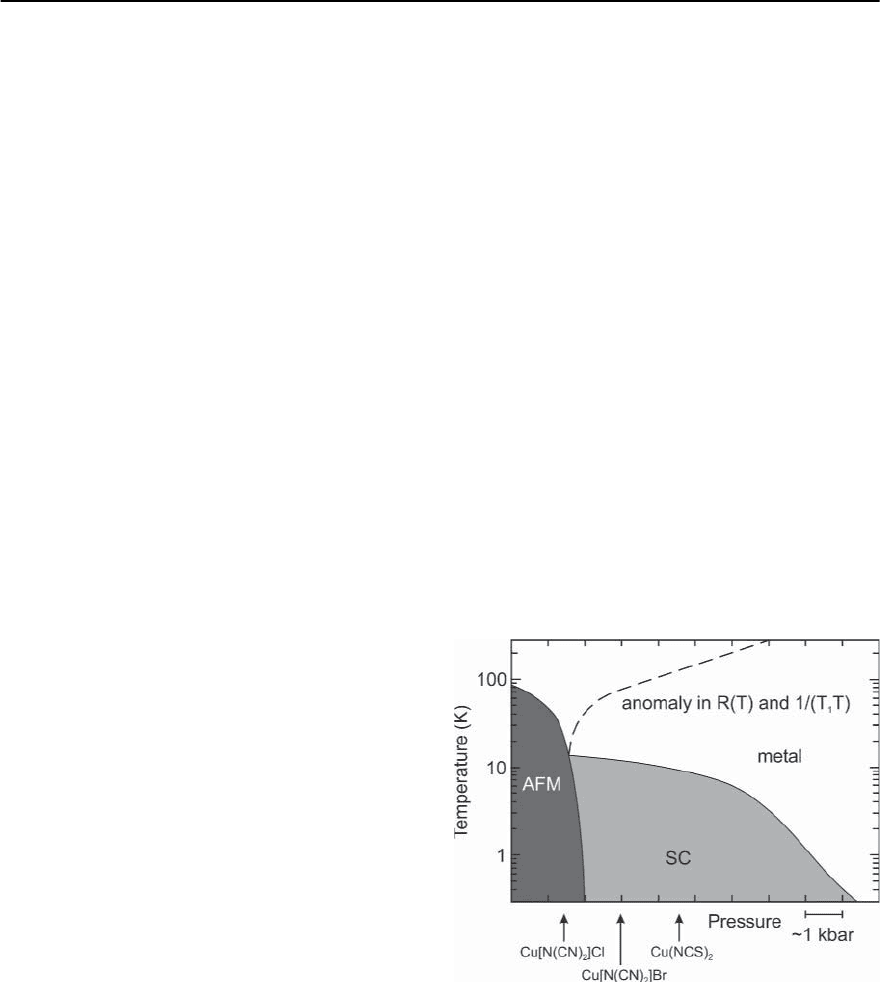
13 Unconventional Superconductivity in Novel Materials 711
FS, may lead to nonequilibrium persistent currents
[498]. This effect might explain the hysteresis loops
observed in ˛-(ET)
2
KHg(SCN)
4
.Inanycase,thenew
and interesting physics of this field-induced phase
deserves further research.
Finally, magnetic field induced superconductiv-
ity (MFIS) has been found between 18 and 41 T in
-(BETS)
2
FeCl
4
[499,500]. At first glance, the evolu-
tion of a superconducting state in a magnetic field is
surprising since the magnetic field usually destroys
superconductivity. In the first experiment in mag-
netic fields up to 20 T [499], the increase of T
c
with
field led to speculations about unconventional pair-
ing interactions caused by magnetic fluctuations via
the Fe moments. In another experiment in fields up
to 42 T, however, a more complete superconducting
phase diagram evolved as shown in Fig. 13.75 [500].
At the lowest temperature (about 0.8 K), the resis-
tance drops to zero at an in-plane field of about 18 T
and becomes finite again at a field of about 41 T. The
superconducting phase could be resolved up to about
4 K. It was also shown that only the in-plane field
component is relevant for the occurrence of super-
conductivity.
One possible explanation for the MFIS observed
in -(BETS)
2
FeCl
4
is the Jaccarino–Peter field-
compensation effect [4], as mentioned in [499]. In
this scenario the applied magnetic field aligns the
S =5/2Fe
3+
moments, which impress an exchange
field J S on the spins s of the conduction electrons
via the exchange interaction J S · s, as described in
Sect. 13.2.4. For J < 0, the applied magnetic field
becomes compensated by the exchange field and
may reach values less than the Pauli paramagnetic
limit, thereby allowing the field-induced supercon-
ducting stateto occur.Oneofthemost striking exam-
ples of the Jaccarino–Peter effect, is provided by the
Chevrel-phase superconductor Eu
x
Sn
1−x
Mo
6
S
8
con-
taining small quantities of Br or Se (see Fig. 13.20)
[101].In this case,superconductivitywith T
c
≈ 3.9K
is first destroyed at about 1T and then restored above
about 4 T but only below 1 K. In -(BETS)
2
FeCl
4
,the
antiferromagnetic state has to be suppressed in high
magnetic fields before the superconducting state can
evolve out of a paramagnetic state.
TheNatureoftheSuperconductingState
For the 2D organic superconductors, the controver-
sial experimental situation still prevents a definite
conclusionas to whetherconventional BCSor uncon-
ventional superconductivity exists. It is generally ac-
cepted thatthe Cooper pairsare ina singlet spin state.
Evidence for a superconducting ground state with
singlet spin pairing includes a vanishing spin sus-
ceptibility detected by NMR experiments [501–503]
and the value of the paramagnetic-limited upper
critical field [504,712]. For the latter analysis, how-
ever, the above mentioned weak-coupling estimate
is not appropriate, since many-body effects have to
be taken into account. An elegant determination of
the Pauli limit has been performed byZuo et al.using
known thermodynamic quantitiessuchas the super-
conducting condensation energy from specific-heat
data and the Pauli spin susceptibility and is taken as
further evidence for a singlet ground state [505].
One motivation for suggesting an unconventional
order parameter, i.e., of singlet d-wave symmetry, is
the nature of the P −T phase diagram of the -phase
superconductors first proposed in [506] (Fig. 13.76).
Fig. 13.76. Schematic P −T phase diagram for the -(ET)
2
X
salts depicting regions of antiferromagnetic insulator be-
havior (AFM) and superconductivity (SC). The arrows in-
dicate starting points for the different materials at ambient
pressure
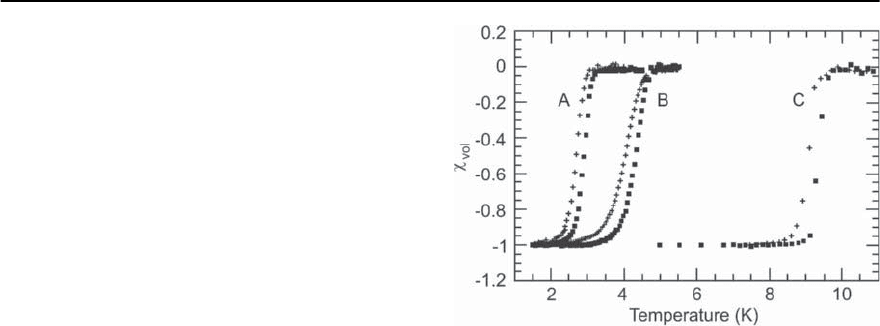
712 M.B. Maple et al.
Next to the superconducting state an antiferromag-
netic insulating state exists, similar to that observed
for the 1D Bechgaard salts and reminiscent of the
phase diagram of many high-T
c
materials. However,
there is only one -phase material known that dis-
plays an antiferromagnetic insulating state at am-
bient pressure that can be suppressed by pressure.
For -(ET)
2
Cu[N(CN)
2
]Cl, a pressure of 300 bar is
sufficient to induce superconductivity at a record
T
c
of about 12.8 K (Fig. 13.76) [392]. A further in-
crease in the hydrostatic pressure rapidly suppresses
the superconducting ground state. In fact, the com-
pound -(ET)
2
Cu(NCS)
2
displays the largest pres-
sure dependence of T
c
yet observed for any super-
conductor, T
c
/p ≈ −3 K/kbar [507]. Thermal-
expansion measurements revealed that T
c
is most
sensitive to uniaxial pressure perpendicular to the
planes [508, 509] indicating that, at least for the
phase, an enlargement of the anion-layer thickness
might increase T
c
even further. However, as evi-
dencedby theP−T phase diagram,the -phase mate-
rials containing large anions reside close to an insu-
lating state,which is proposed to be a Mott–Hubbard
insulating state driven by the small bandwidth and a
large Coulomb interaction [397,398,510–512]. This
metal-insulator transition — under intense study
now — reveals an unusual criticality beyond the
known universality classes [513]. Additional stud-
ies are necessary to gain a better understanding on
the nature of this metal-insulator transition in 2D
organic metals.
A key experiment that provided evidence for the
electron–phonon interaction as the pairing interac-
tion in the early superconductors was the detection
of an isotope effect, i.e., the increase of T
c
propor-
tional to m
−1/2
as predicted by BCS theory. For the
organics, m is some average molecular mass. At first
sight, a somewhat confusing picture exists for the 2D
organic superconductors.Substitutionofalleighthy-
drogens in the ET ethylene end groups by deuterium
causes an enhancement of T
c
by about 0.3 K for
three different organic superconductors (Fig. 13.77)
[514]. This effect is not only inverse to what is ex-
pected but, in addition, the size of the T
c
shift is
much larger than would be explicable by a simple
molecular-mass change. Apparently, the interaction
Fig. 13.77. Representative superconducting transition
curves measured by ac susceptibility for (A)
L
-
(ET)
2
Ag(CF
3
)
4
, (B) ˇ
-(ET)
2
SF
5
CH
2
CF
2
SO
3
,and(C) -
(ET)
2
Cu(NCS)
2
. Plus symbols are for hydrogenated, filled
squares for deuterated samples [514]
between the outer parts of the ET molecules and the
anions plays a crucial role in the pairing strength.
This interaction is expected to be rather sensitive
to uniaxial pressure perpendicular to the planes. As
mentioned, this was indeed confirmed by thermal-
expansion measurements which extracted an initial
reduction of T
c
by 6 K/kbar for ˇ
-(ET)
2
SF
5
CH
2
-
CF
2
SO
3
and -(ET)
2
Cu(NCS)
2
[509]. With this re-
sult in mind, the inverse isotope effect can be un-
derstood by the smaller zero-point displacement of
the carbon-deuteriumbonds compared to the lighter
carbon-hydrogen bonds. This results in a reduced
internal lattice pressure and, consequently, in an in-
creased T
c
for the deuterated samples [514].
In order to avoid any changes of the anion-
hydrogen interaction, experiments were carried out
on samples in which only central atoms of the ET
molecules were exchanged. Substitution of four
12
C
atoms by
13
Candalleight
32
Satomsby
34
Sresultedin
areductionofT
c
of about 1% [515]. This agrees well
with the BCS expectation and provides strong sup-
port for a Cooper-pair coupling which is at least par-
tially mediated by phonons. Additional support for
this scenario comes from Raman data which showed
a clear hardening of the Raman modes below T
c
for -(ET)
2
Cu[N(CN)
2
]Br [516] and from inelastic
neutron-scattering experiments [517]. In the latter

13 Unconventional Superconductivity in Novel Materials 713
Fig. 13.78. Temperature dependences of the in-plane pen-
etration depths extracted from (a) dc-magnetization mea-
surements [518] and (b) by use of a high-frequency tunnel-
diode-oscillator technique [519]. The inset in (a) shows
the low-T data in an enlarged scale together with model
curves for BCS (solid line) and for two triplet states, t
1
and t
4
(broken curves)Thedatain(b) are for two sam-
ples of -(ET)
2
Cu[N(CN)
2
]Br (1,2) and two samples of -
(ET)
2
Cu(NCS)
2
(3,4)
measurement a significant shift of a phonon branch
was observed below T
c
, an effect hardly seen this
clearly in any other superconductor. Consequently,
there are a number of experiments indicating an
electron-phonon mechanism for superconductivity
in organic superconductors, whereas the argument
for a pairing mechanism mediated by antiferromag-
netic fluctuations is largely based on the P − T phase
diagram (Fig. 13.76).
Apart from the coupling mechanism in the or-
ganic superconductors, the symmetry of the order
parameter is a highly controversial issue. The exper-
imental situation appears to be rather inconclusive
and only some aspects shall be presented. For fur-
ther discussion of this topic see [395,396,399–402].
One quantity which should reflect the symme-
try of the order parameter is the magnetic pene-
tration depth, (T). For a conventional BCS s-wave
gap, should exhibit an exponential temperature de-
pendence, whereas for a superconducting gap with
nodes a power-law T dependence is expected. The
serious experimental problems in determining re-
liably are illustrated in Fig. 13.78. In Fig. 13.78(a)
the magnetic penetration depth is determined by
dc-magnetization measurements [518]; whereas, in
Fig. 13.78(b) the same quantity is extracted utiliz-
ing a tunnel-diode-oscillator technique [519]. In the
former experiment by Lang et al., the magnetization
data can be very well described by the conventional
weak-coupling BCS theory as shown by the solid line
in Fig. 13.78(a). The broken lines represent model
curves for two earlier suggested triplet states. In the
high-resolution data of Carrington et al. [519],a T
3/2
variation of is found,in contrast to the BCS results
of Lang et al. as well as other groups, and, in addi-
tion, different from the T
2
behavior previously re-
ported by others. This inconclusive picture prevails
in a number of other experiments utilizing differ-
ent techniques which report either BCS or uncon-
ventional behavior of (see [395,396,399–402] for
more details). The temperature dependence of the
spin-lattice relaxation rate, 1/T
1
,fromNMRmea-
surements is often used to obtain information about
nodes in the superconducting energy gap.Usually,an
increase of 1/T
1
just below T
c
is expected, known as
the Hebel–Slichter coherence peak (see Fig. 13.80).
Although the occurrence of this peak is an impor-
tant proof of BCS superconductivity,itsabsence can-
not disprove conventional superconductivity as ev-
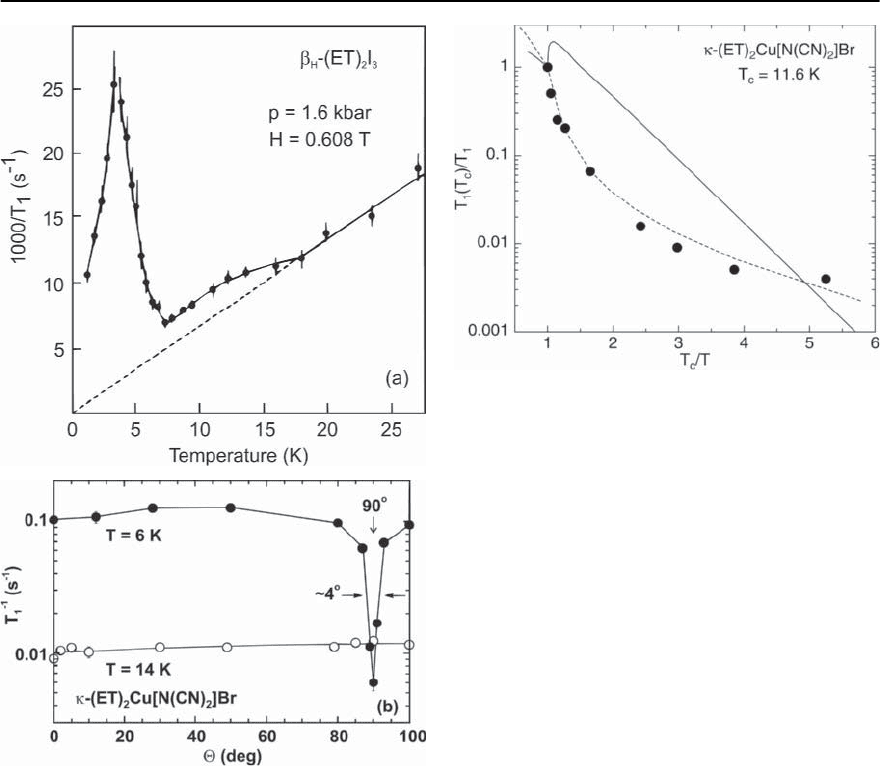
714 M.B. Maple et al.
Fig. 13.79. Proton NMR spin-lattice relaxation rates T
−1
1
.
(a) Temperature dependence of 1000/T
1
for ˇ
H
-(ET)
2
I
3
(T
c
≈ 8 K) [520, 521]. (b) Angular dependence of 1/T
1
for -(ET)
2
Cu[N(CN)
2
]Br (T
c
≈ 11.5K)aboveandbelow
T
c
[522]
idenced by the missing peak for the BCS supercon-
ductors Nb and V. At low temperatures, 1/T
1
is pre-
dicted to vanish exponentially for a fully-gapped su-
perconductor,and display a power-law T dependence
when the superconducting energy gap goes to zero at
points or lines on the Fermi surface (see Fig. 13.80).
Early proton-NMR experiments received partic-
ular attention when reporting an unexpected en-
Fig. 13.80. Temperature dependence of the normalized
spin-lattice relaxation rate.The solid line depicts the behav-
ior for the weak-coupling BCS superconductor aluminum
[523]. Data from
13
CNMRfor-(ET)
2
Cu[N(CN)
2
]Br in
fields parallel to the conducting ET planes are shown as
closed circles [501] and dashed line [502]. There is no
Hebel–Slichter peak and the relaxation rate decreases as
T
3
rather than exponentially
hancement of 1/T
1
by about a factor of 10 at ∼ T
c
/2
as seen in Fig. 13.79(a) [520, 521]. Similar results
were reported for many other organic superconduc-
tors and caused considerable confusion at the time.
This feature was only understood a number of years
later when an NMR measurement of the angular-
dependence of 1/T
1
showed that the strong enhance-
ment of 1/T
1
below T
c
vanishes when the magnetic
field is aligned within the ET planes (Fig. 13.79(b)).
Below T
c
,1/T
1
exhibits a sharp dip in a narrow an-
gular region about 4
◦
wide around this field orien-
tation ( =90
◦
). It is therefore clear that this ef-
fect is connected with the flux-line vortex dynam-
ics in the Shubnikov state. In the reversible region,
the flux lines are free to move which results in a
rapidly changing magnetic fieldat the hydrogen sites
and, consequently, causes the strongly enhanced re-
laxation rate. However, when the magnetic field lies
within the ET planes the flux lines prefer to stay
within the poorly conducting anion layers, which
results from a well-known phenomenon called in-
trinsic pinning. For this field orientation, the mag-
netic field at the hydrogen sites remains approxi-

13 Unconventional Superconductivity in Novel Materials 715
mately constant and 1/T
1
approaches the expected
intrinsic value. In the organic metals, the hydrogen
nucleus has a relatively weak coupling to the conduc-
tion electrons residing in the spatially distant ET lay-
ers. Therefore, the relaxation due to the moving flux
lines easily dominates. This is in contrast to the sit-
uation for the cuprate superconductors, where very
large relaxation rates due to the conduction electrons
occur that mask the flux-line effect.
After realizing this important additional relax-
ation channel, NMR experiments were performed
with the magnetic field aligned within the ET lay-
ersand,inaddition,the
13
Cnucleiwerechosenasa
local probe since they are located in the center of the
ET molecules,closer to the itinerant-electron system.
Three groups almost simultaneously reported com-
parable results [501–503], two of which are shown
schematically in Fig. 13.80. There are several marked
differences between the experimental results and the
behavior fora BCS superconductor(shown as a solid
line) [523]. First, the coherence peak just below T
c
is absent (although this is not conclusive evidence
for unconventional superconductivity, as mentioned
above). Second, 1/T
1
follows a T
3
dependence that
provides strong evidence for a node-like structure of
the energy gap. The rapid decrease of 1/T
1
just be-
low T
c
suggests a very fast gap opening, i.e., much
faster than is realized for a conventional supercon-
ductor. One should bear in mind, however, that all
of the NMR experiments were performed in an ap-
plied magnetic field, which might influence the gap
structure even if the vortex dynamics can be ne-
glected.
In light of the controversial issue of the symme-
try of the superconducting gap in the 2D organic
superconductors, all of the above measurements as
well as the specific-heat measurements discussed
below provide no information about the detailed
nodetopology.Therefore,the recentattempts to mea-
sure the possible anisotropy of the order parame-
ter directly received particular attention. The first
report of gap nodes in -(ET)
2
Cu(NCS)
2
[524] was
argued to be a misinterpretation of the millimeter-
wave magneto-optical data [525,526]. In other work,
scanning-tunneling spectroscopy (STM) was utilized
to measure the in-plane anisotropy of the supercon-
ducting gap [527]. The STM tip was placed on vari-
ous as-grown or in-air prepared surfaces perpendic-
ular to the interlayer direction.Strongly anisotropic
current–voltage spectra were recorded, which were
interpreted as being consistent with d-wave pairing.
In line with this result, thermal-conductivity mea-
surements in applied magnetic fields revealed a four-
fold symmetry of the electronic contribution to the
thermal conductivity [528]. Interestingly, however,
these two experiments disagree on the node direc-
tions in -(ET)
2
Cu(NCS)
2
. One should further keep
in mind that both experiments can only manifest an
asymmetry of their signals but cannot verify real zero
points of the energy gap. Furthermore, STM investi-
gations are naturally extremely sensitive to surface
states and should, therefore, be performed on well-
characterized surfaces. Finally, the thermal conduc-
tivity due to quasiparticle excitation had to be mea-
sured in an applied magnetic field leading to similar
difficulties as mentioned for the NMR experiments
above.
The proposed zero-field nodes of the supercon-
ducting gap should result in power-law temperature
dependences of the thermal conductivity and the
specific heat and finite values at T = 0. Indeed, in
one thermal-conductivity study a small residual lin-
ear contribution was reported [529]; however, it is
questionable whether the chosen extrapolation from
above ∼ 0.18 K towards low temperatures, assuming
a linear electronic and cubic phonon contribution,
is justifiedor not. Recent thermal-conductivity mea-
surements showed that the phonon-scattering length
down to lowest temperatures (T =0.25K) is strongly
influenced by quasiparticle scattering preventing the
evolution of the T
3
dependence expected for sample-
boundary scattering of phonons [530]. Therefore,
further studies are needed to clarify this issue.
Specific heat, C, is a powerful technique for de-
termining whether the superconducting energy gap
goes to zero at nodes on the Fermi surface. If the
quasiparticle contribution to the specific heat, C
es
,
vanishes with an exponential temperature depen-
dence in the superconducting state, nodes in the en-
ergy gapcan be ruled outunequivocally.On the other
hand, a power-law in T dependence of C
es
indicates
that line or point nodes may be present. However, a
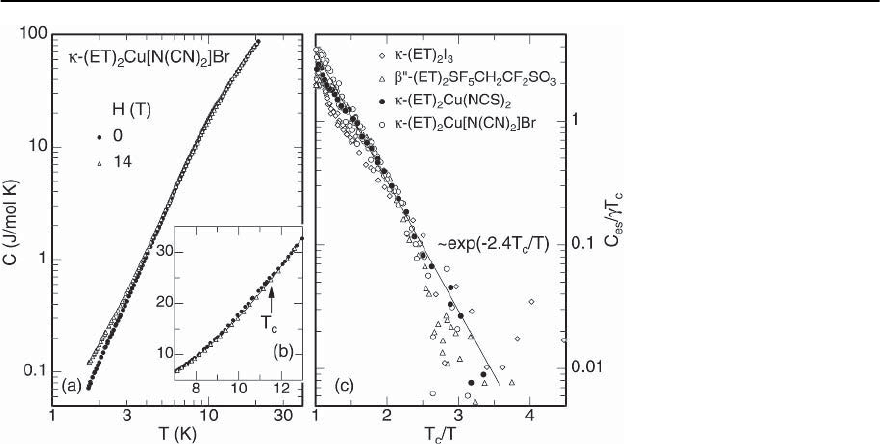
716 M.B. Maple et al.
Fig. 13.81. (a) Specific heat of -
(ET)
2
Cu[N(CN)
2
]Br in the su-
perconducting (H =0)and
normal (H = 14 T) state. (b)
The anomaly at T
c
=11.5K
is weakly visible in the inset.
(c) Normalized plot of the elec-
tronic contribution to the spe-
cific heat C
es
in the supercon-
ducting state divided by T
c
as a function of T
c
/T.The
solid line shows the exponen-
tial vanishing of C
es
towards
low T (fit to the data of -
(ET)
2
Cu(NCS)
2
)
power-law dependence in the specific heat needs to
be checked carefully since any extrinsic effect such
as a partially normal-conducting sample or an im-
proper subtraction of the nonelectronic contribu-
tions to C can obscure the exponential temperature
dependence and lead to incorrect conclusions.
Measurements of C(H,T)for-(ET)
2
C u [N (C N)
2
]Br
[531] are shown in Fig. 13.81(a) on a double-loga-
rithmic scale. The electronic contribution to C is
rather small, only about 1% at T
c
=11.5K.There-
fore, the specific-heat anomaly at T
c
can only be re-
solved in a high-resolution experiment (see the en-
largement of the data in Fig.13.81(b)). In a magnetic
field of 14 T applied perpendicular to the planes, the
sample is in the normal state. Therefore, the data at
H = 14 T comprises the phonon contribution and
thenormal-stateelectronicspecificheat T,where
the Sommerfeld coefficient ≈ 25 mJ/mol K
2
.Con-
sequently, C
es
can be extracted by subtracting the
phonon contribution from the C data in H =0.As
evidenced in the normalized plot of Fig. 13.81(c),
C
es
vanishes exponentially for -(ET)
2
Cu[N(CN)
2
]Br
[531] as well as for three other organic superconduc-
tors [530, 532, 533]. These results are in agreement
with recent reports by other groups [534,535]. How-
ever,the C(H, T) measurements are not sensitiveto a
particular direction in k space and therefore cannot
resolve any possible anisotropy of the superconduct-
ing gap. In a very recent specific-heat experiment a
T
2
behavior in C
es
was resolved at lower tempera-
tures [713].Although this result would be consistent
with line nodes,the increase of linear with H rather
points to a conventional gap symmetry.
An analysis of the specific-heat jump at T
c
yields
an interesting trend (Fig. 13.82). For the four super-
conductors shown,with values of T
c
between 3.4 and
11.5K, the specific-heat jump at T
c
is always larger
than the weak-couplingvalue C/ T
c
=1.43 and in-
creases monotonically with increasing T
c
[400,531].
This provides direct evidence for an increasing cou-
pling strength with T
c
.The dashed lines in Fig.13.82
represent the weak-coupling C dependence [536],
while the solid lines describe strong-coupling be-
havior; a BCS-like T dependence of the energy gap
(T) scaled by an appropriate parameter has been
assumed [537]. Reasonable descriptions of the ex-
perimental data are achieved for the gap ratios
˛ = (0)/k
B
T
c
given in Fig. 13.82, where ˛ =1.76
in the weak-coupling limit. The coupling strengths
can be estimated [531] using phenomenological
models, yielding values ranging from ∼ 0.8 for -
(ET)
2
I
3
(T
c
=3.4 K) to 2.5 for -(ET)
2
Cu[N(CN)
2
]Br
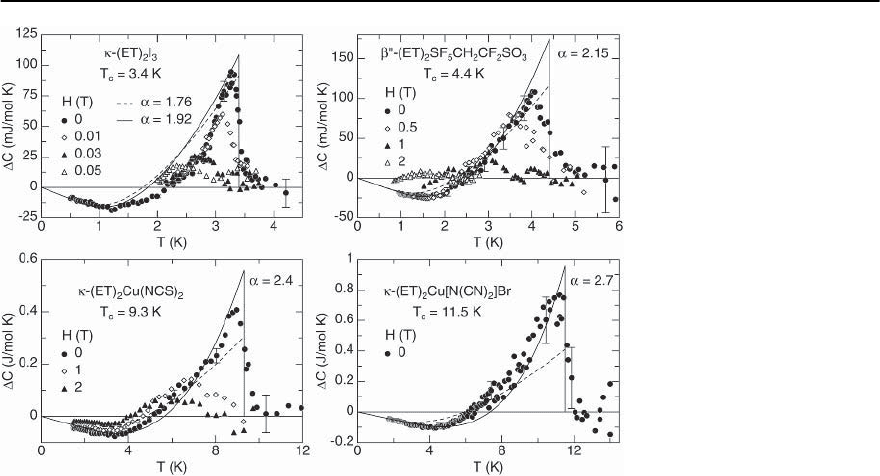
13 Unconventional Superconductivity in Novel Materials 717
Fig. 13.82. Specific heat in the
superconducting state minus
the specific heat in the nor-
mal state for four different
organic superconductors with
values of T
c
between 3.4 and
11.5K. The lines show the pre-
dicted BCS behavior for weak
coupling (dashed lines, ˛ =
1.76) and for strong coupling
characterized by various values
of the parameter ˛ (solid lines)
(T
c
=11.5K). The large values of are in rough
agreement with the mass renormalizations extracted
from magnetic quantum oscillations [410,449].
13.4.4 Concluding Remarks
The organic metals and superconductors show a rich
variety of novel ground statesand cover a broad spec-
trum of tunable fundamental physical phenomena
that are of current interest. One of the most stud-
ied, but still very controversial, issues is the nature
of the superconductivity. Forthe 1D Bechgaard salts,
earlier indications for triplet superconductivity had
to be corrected by recent results. For the 2D organic
superconductors, the experimental situation is un-
settled. NMR and thermal-conductivity experiments
suggest that the superconducting order parameter
is unconventional, whereas the measurements of the
specific heat indicate a nodeless gap. In an attempt
to solve this puzzling situation, it was suggested that
an s wave to d-wave gap-symmetry transition could
be induced by an in-plane magnetic field [538]. In
this theoretical treatment, phonon-mediated super-
conductivity with a small wavevector was assumed,
which could explain such a transition. Although this
proposal would resolve the controversial NMR and
specific-heat results, other predictions of this the-
ory such as the orientation of the d-wave gap nodes
are at odds with recent experimental results [528].
Further studies, especially experiments that directly
probe the phase difference of the superconducting
wave function, are highly desirable.
13.5 Layered Cuprate and Ruthenate
Superconductors
13.5.1 Introduction
The discovery of superconductivity at ∼ 30 K in the
La–Ba–Cu–O system by Bednorz and M¨uller in 1986
ignited a worldwide explosion of research on high
temperature superconductivity that still persists af-
ter more than one and a half decades. The impe-
tus behind this extraordinary episode in the his-
tory of science has been driven by two objectives:
the development of a fundamental understanding
of high temperature superconductivity and the wide
spread use of high temperature superconductors in
technological applications. Although an enormous
amount of progress has been made on these chal-
lenging problems since 1986, many obstacles remain
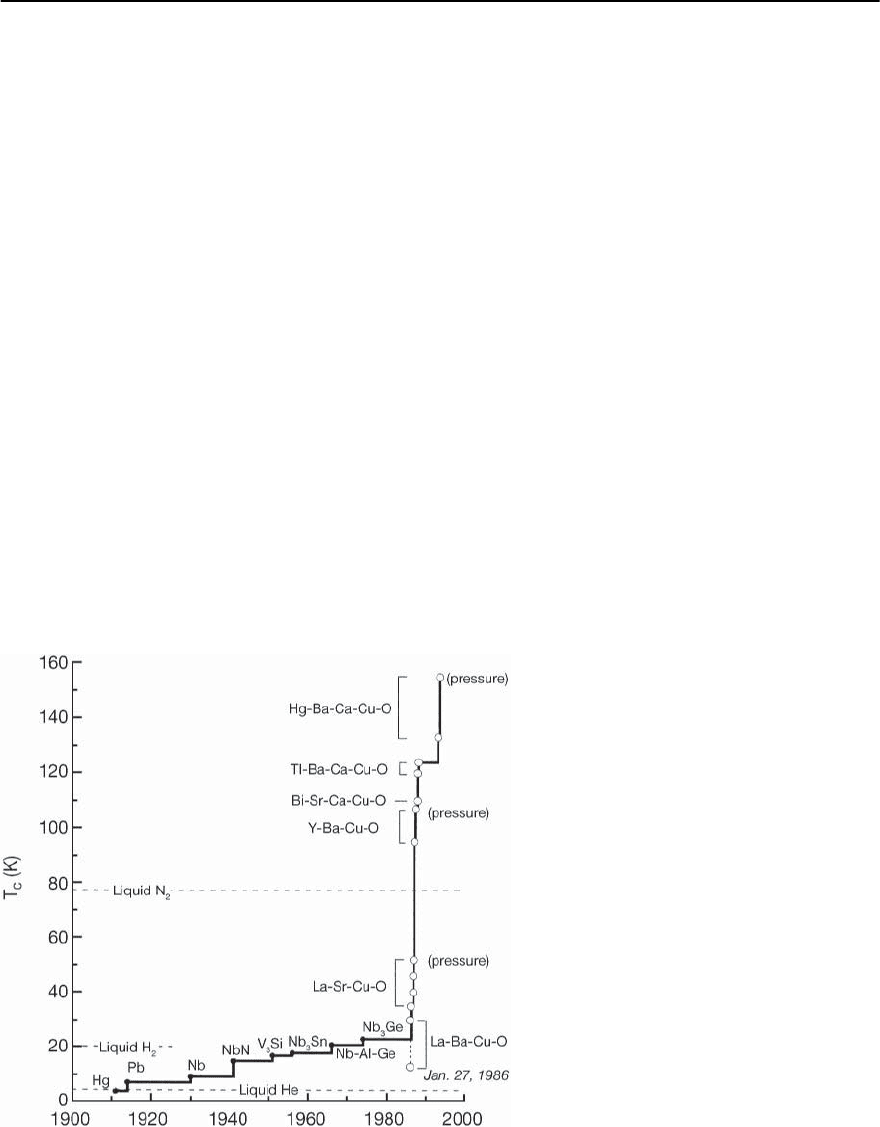
718 M.B. Maple et al.
to be overcome before these two objectives can be
achieved.
In this section, we give an overview of the cur-
rent knowledgeand understandingof the fundamen-
tal aspects of high T
c
superconductivity in cuprates.
We begin with a brief introduction to the layered
perovskite-like cuprate materials that have been
studied the most extensively as well as the struc-
turally related ruthenocuprate magnetic supercon-
ductorsand the compound Sr
2
RuO
4
,the leading can-
didate for p-wave superconductivity.The rest of this
section is devoted to a brief survey of the extraor-
dinary superconducting and normal state physical
properties of the high T
c
cuprate superconductors
and a discussion of some of the concepts and notions
that have been advanced to account for these prop-
erties. Specific topics discussed include: materials,
structure and charge carrier doping, superconduct-
ing state properties (critical field and current den-
sities, superconducting pairing mechanism, doping
dependence of T
c
, symmetry of the superconducting
order parameter), and normal state properties (non-
Fermi liquid behavior, normal ground state, pseu-
dogap, electronic inhomogeneity) and the generic
phase diagram. The enormous scope of this subject
dictated a very selective choice of the examples cited
to illustrate the progress made in this field since
its inception in 1986. For comprehensive accounts
of specific topics in high T
c
superconductivity, the
reader is referred to various review articles, such as
those that appear in the volumes edited by Ginsberg
[539] and by Gschneidner, Eyring and Maple [540].
The materials that are emphasized in this section in-
clude the hole-dopedsuperconductors La
2−x
M
x
CuO
4
(M = Ba, Sr, Ca, Na), RBa
2
Cu
3
O
7−ı
(R = Y or
Ln), Y
1−x
Pr
x
Ba
2
Cu
3
O
7−ı
,Bi
2
Sr
2
CaCu
2
O
8+ı
, and the
electron-doped superconductors Ln
2−x
M
x
CuO
4−y
(Ln=Pr,Nd,Sm,Eu;M=Ce,Th).
13.5.2 The Materials
Since 1986, dramatic increases of T
c
have been
achieved in the layered perovskite-like cuprate su-
perconductors, as illustrated in the plot of the maxi-
mum value of T
c
vs date in Fig. 13.83. Prior to 1986,
therecordforthehighestvalueofT
c
(∼ 23 K) was
heldbytheA15compoundNb
3
Ge [541]. Currently,
the maximum value of T
c
at atmospheric pressure is
∼133 K for the compound HgBa
2
Ca
2
CuO
8
[542,543].
When this compound is subjected to high pressures
Fig. 13.83. Maximum superconducting critical
temperature T
c
vs date ( [546])

13 Unconventional Superconductivity in Novel Materials 719
of ∼ 30 GPa,the T
c
onset increases to ∼ 164 K (more
than halfway to room temperature!) [544,545].
The first superconducting oxide system found
with T
c
values exceeding the 23 K record value held
by Nb
3
Ge was La
2−x
Ba
x
CuO
4
, which has a maximum
value of T
c
of ∼ 30 K for x ≈ 0.15 [547,548]. Shortly
thereafter, La
2−x
M
x
CuO
4
systems with M = Sr, Ca,
and Na were synthesized that exhibited supercon-
ductivity with maximum values of T
c
of ∼ 40 K for
M = Sr [549], ∼ 20 K for M = Ca [550], and ∼ 20 K
for M = Na [551,552].
The first superconductors with values of T
c
ex-
ceeding the boiling point of liquid nitrogen (77 K)
belong to the RBa
2
Cu
3
O
7−ı
family. Superconductiv-
ity was reported to occur for R = Y [553] and all
of the lanthanides except Ce and Tb (which do not
form the phase) and Pr (which forms the phase, but
is insulating and thereby not superconducting) with
T
c
values that range from ∼ 92 K for R = Y to
∼ 95 K for R = Nd [554]. Superconductivity at ∼ 90
K in the lanthanide analogues of YBa
2
Cu
3
O
7−ı
was
discovered independently in laboratories at several
institutions throughout the world. (See, for exam-
ple, [554] and references cited therein.) Surprisingly,
superconductivity with T
c
∼ 85 K has been reported
in PrBa
2
Cu
3
O
x
samples prepared by the traveling
floating zone method [555]. However, these mate-
rials show large inhomogeneity in both lattice pa-
rameters and transport and magnetic properties. In
the parts of the sample that exhibit bulk supercon-
ductivity, the c-axis lattice constant is reported to be
larger than that of the nonsuperconducting ceramic
polycrystalline or single crystal samples prepared by
standard methods. The pressure dependence of T
c
of
the PrBa
2
Cu
3
O
x
samples is quite large and compara-
ble to values observed in underdoped cuprates. Fur-
ther research on this fascinating material is clearly
warranted, although to date the superconductivity
reported for PrBa
2
Cu
3
O
x
has not been confirmed.
These results illustrate the complexity of these ma-
terials and how sensitive their properties are to the
conditions of their growth.
Like most high T
c
cuprates, the La
2−x
M
x
CuO
4
and
RBa
2
Cu
3
O
7−ı
compounds are hole-doped supercon-
ductors. The first system of electron-doped cuprate
superconductors discovered was Ln
2−x
M
x
CuO
4−y
(Ln=Pr,Nd,Sm,Eu;M=Ce,Th;x ∼ 0.1−0.18; y ≈
0.02) {(Ln = Pr, Nd, Sm; M = Ce) [556]; (Ln = Nd; M
= Th) [557]; (Ln = Pr,Sm; M = Th) [558]; (Ln = Eu; M
= Ce) [559].} The highest values of T
c
found among
the electron-doped superconductors are ∼ 25 K.
There has been considerable interest in systems
ofthetypeR
1−x
Pr
x
Ba
2
Cu
3
O
7−ı
, especially for R =
Y [282]. This was initially inspired by the puzzling
observation that PrBa
2
Cu
3
O
7−ı
, when prepared by
standard methods, is insulating and nonsupercon-
ducting,whereas the other RBa
2
Cu
3
O
7−ı
compounds
that can be formed are metallic and superconduct-
ing with values of T
c
∼ 92 − 95 K, as noted above.
The Y
1−x
Pr
x
Ba
2
Cu
3
O
7−ı
system is replete with ex-
traordinary physical phenomena including a metal-
insulator transition at x
cr
≈ 0.55, a monotonic de-
pression of T
c
with x that vanishes near x
cr
in the
metallic phase, a striking crossover in the pres-
sure dependence of T
c
from positive to negative
with increasing x,alarge T contribution to the
low temperature specific heat that is reminiscent
of heavy fermion behavior, and Cu
2+
and Pr
n+
an-
tiferromagnetic (AFM) ordering in the insulating
phase with T
N
(Cu
2+
) > T
N
(Pr
n+
), where T
N
is the
N´eel temperature. It has been suggested that these
and other peculiar properties of this system are re-
lated to hybridization between the Pr localized 4f
states and the valence band states associated with
the conducting CuO
2
planes [282]. A theoretical
model that involves the hybridization between the
4f states of Pr and the 2p states of neighboring
oxygen atoms in the Y
1−x
Pr
x
Ba
2
Cu
3
O
7−ı
system has,
in fact, been developed by Fehrenbacher and Rice
[560]. Similar phenomena are found in the related
Y
1−x
Pr
x
Ba
2
Cu
4
O
8
system which has also been exten-
sively investigated [561].The striking behaviorof the
Y
1−x
Pr
x
Ba
2
Cu
3
O
7−ı
system is discussed throughout
this section.
In several of the compounds containing R layers,
the R ions with partially-filled 4f electron shells and
magnetic moments have been found to order antifer-
romagnetically at lowtemperature[554,562].Specific
heat data for RBa
2
Cu
3
O
7−ı
with R = Nd, Sm, Gd, Er
and Dy that exhibit AFM ordering of the R ions at
low temperatures reveal pronounced peaks near the
N´eel temperature T
N
as shown in Fig. 13.84 [562].

720 M.B. Maple et al.
Fig. 13.84. Specific heat C vs temperature between 0.5 K
and 3 K for RBa
2
Cu
3
O
7−ı
compounds with R = Nd, Sm, Gd,
Dy, and Er, after [562]
Several compounds containing CuO
2
and RuO
2
planes have been fabricated in which supercon-
ductivity and ferromagnetism, apparently confined
to the CuO
2
and RuO
2
planes, respectively, have
been reported to coexist with one another mi-
croscopically. Examples of these materials include
R
1.4
Ce
0.6
RuSr
2
Cu
2
O
10−ı
(T
c
∼ 42 K, Curie temper-
ature
c
∼ 180 K for R = Gd; T
c
∼ 32 K,
c
∼ 122 K
for R = Eu) [563] and GdRuSr
2
Cu
2
O
8
(T
c
∼46 K,
c
∼
132 K) [564,565]. Magnetic order in the compound
GdRuSr
2
Cu
2
O
8
has been studied by means of neu-
tron diffraction measurements by Lynn et al. [566].
The Ru magnetic moments order antiferromagneti-
cally at T
N
= 136 K,coincidentwith the previously re-
ported onset of ferromagnetism. Neighboring spins
are antiparallel in all three directions,with a low tem-
perature moment of 1.18
B
along the c-axis. These
measurements place an upper limit of ∼ 0.1
B
to
any net zero field moment, with fields exceeding 0.4
tesla needed to induce a measurable magnetization.
The Gd ions order independently at T
N
=2.5Kwith
thesamespinconfiguration.ThevalueT
N
= 136 K
for AFM ordering of the Ru ions is by far the high-
est known N´eel temperature for antiferromagnetic
ordering that coexists with superconductivity. In ad-
dition to these rare earth andactinide based cuprates,
many other high T
c
cuprates have been discovered, a
number of which also contain rare earth elements.
The superconducting compound Sr
2
RuO
4
has the
same crystal structure as the La
2−x
M
x
CuO
4
(M = Ba,
Sr, Ca, Na) high T
c
cuprate superconductors [571].
While the T
c
of Sr
2
RuO
4
is only ∼ 1K,thiscom-
pound is of considerable interest because it is the
only layered perovskite-like superconductor without
Cu and it appears to be a leading candidate for p-
wave superconductivity. The anisotropy of the su-
perconducting properties of Sr
2
RuO
4
is very large
( =
ab
/
c
≈ 26), where is the superconducting
coherence length. Although this anisotropy is larger
thanthat of La
2−x
M
x
CuO
4
,thein-planeandc-axis re-
sistivities of Sr
2
RuO
4
vary as T
2
at low temperature,
indicative of Fermi liquid behavior. Based on sim-
ilarities to
3
He and the existence of closely related
oxides such as SrRuO
3
that are ferromagnetic, it was
suggested [572,573] that Sr
2
RuO
4
may exhibit p-wave
(L = 1) spin-triplet superconductivity. In contrast,
the cuprate superconductors are generally derived
by doping the CuO
2
planes of antiferromagnetic par-
ent compounds by means of chemical substitutions,
apparently resulting in superconductivity with spin-
singlet pairing in a d -wave (L = 2) channel.
There is a considerable amount of evidence for
unconventional superconductivity in Sr
2
RuO
4
[569,
570,574].
17
O NMR Knight shift [321] and spinpolar-
ized neutron scattering [567] measurements provide
the principal evidence for spin-triplet pairing of su-
perconducting Sr
2
RuO
4
. These measurements reveal
that there is no reduction of the conduction elec-
tron spin susceptibility
s
(T) in the superconduct-
ing state relative to that
n
(T)inthenormalstate.
For singlet spin pairing,
s
(T)shouldvanishatlow
temperatures T T
c
. Although spin orbit scatter-
